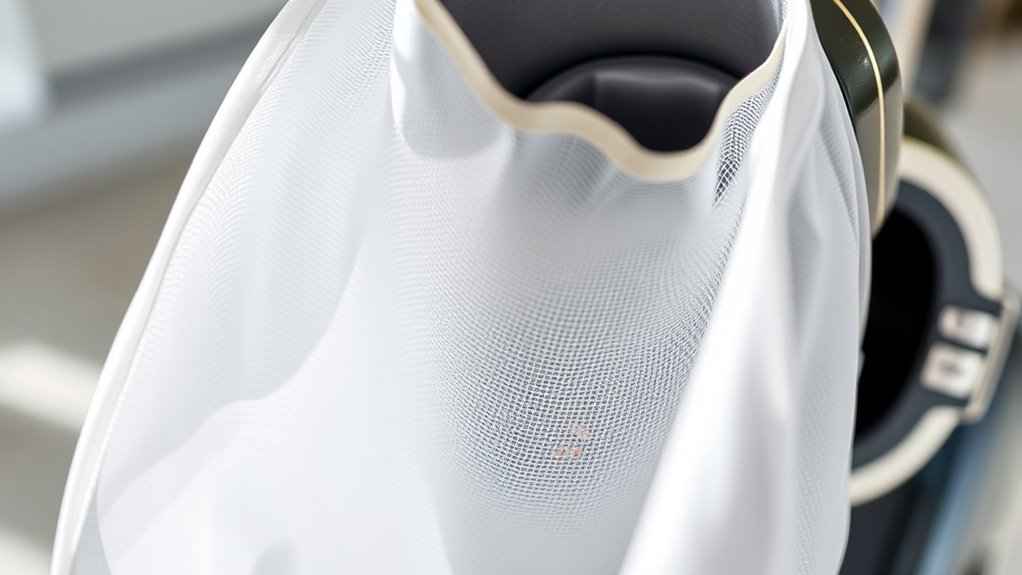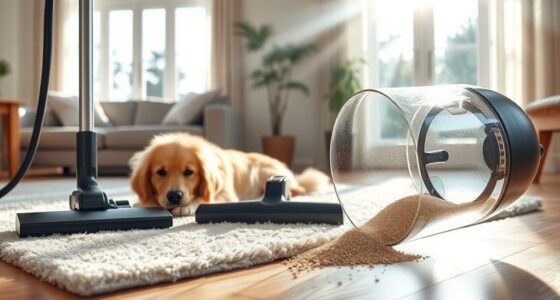Hypoallergenic vacuum bags help minimize allergen exposure by trapping tiny particles like pollen, pet dander, and dust mites more effectively than standard bags. They prevent allergens from escaping back into your home environment, keeping the air cleaner and reducing allergy symptoms. Look for bags with HEPA filters and multiple layers that lock allergens inside. Regularly changing these bags guarantees ongoing allergen control. Keep exploring to discover more ways to create a healthier, allergy-friendly home environment.
Key Takeaways
- Hypoallergenic vacuum bags are designed to trap allergens more effectively than standard bags, reducing indoor allergen levels.
- They often incorporate HEPA filtration to capture microscopic particles like pollen and dust mites.
- Tightly woven or treated materials prevent dust mites and allergens from escaping during disposal.
- Using these bags minimizes allergen leakage, helping to prevent allergen reintroduction into living spaces.
- Regularly replacing hypoallergenic bags maintains vacuum efficiency and consistent allergen control.

Are you tired of sneezing and allergy flare-ups every time you vacuum? If so, switching to hypoallergenic vacuum bags can make a notable difference. These specialized bags are designed to trap allergens more effectively than standard options, helping you breathe easier and reduce allergy symptoms. One of the key features to look for is HEPA filtration. HEPA (High Efficiency Particulate Air) filters are built to capture tiny particles, including pollen, pet dander, mold spores, and dust mites, which are common triggers for allergies. When you use vacuum bags with HEPA filtration, you minimize the amount of allergens that escape back into the air, ensuring that your indoor environment stays cleaner and healthier.
Switch to hypoallergenic vacuum bags with HEPA filters for a cleaner, healthier home free from allergens.
Dust mite control is another critical benefit of hypoallergenic vacuum bags. Dust mites thrive in household dust, bedding, and upholstered furniture, and their microscopic waste particles can cause allergic reactions. Regular vacuuming with high-quality bags equipped for dust mite control helps eliminate these tiny pests and their debris. These bags are often made from tightly woven materials that prevent dust mites and their waste from escaping, trapping them securely until disposal. This not only improves air quality but also reduces the likelihood of dust mite proliferation in your home.
Using hypoallergenic vacuum bags with HEPA filtration also prevents the common problem of allergen leakage. Standard vacuum bags tend to let smaller particles slip through or escape when you empty them, defeating their purpose. Hypoallergenic bags are designed with multiple layers or specially treated materials that lock in allergens more effectively. As a result, you avoid redistributing dust and allergens back into your living space when you change the bag. This feature is especially beneficial if you or someone in your household suffers from asthma or severe allergies, as it substantially reduces exposure.
Furthermore, these bags are generally easy to replace and maintain, ensuring consistent allergen control. When you notice the bag is full, simply remove it carefully to prevent dust from spilling, and dispose of it in a sealed trash bag. Regularly replacing hypoallergenic vacuum bags not only keeps your vacuum functioning efficiently but also maintains a healthier home environment.
Frequently Asked Questions
Can Hypoallergenic Vacuum Bags Be Reused?
You shouldn’t reuse hypoallergenic vacuum bags because doing so can compromise their ability to trap allergens effectively. Reusing increases the risk of bag disposal issues and may release dust and allergens back into your home. For allergy relief tips, always replace bags promptly and choose high-quality, sealed hypoallergenic bags. This guarantees maximum allergen containment, promotes cleaner air, and keeps your allergy symptoms in check.
Are Hypoallergenic Bags Compatible With All Vacuum Models?
You’ll find hypoallergenic vacuum bags aren’t compatible with all vacuum models, so it’s crucial to check your vacuum’s size and design before purchasing. Imagine fitting a key into a lock—if the sizes don’t match, it won’t work smoothly. To guarantee a perfect fit, follow bag replacement tips like measuring your current bag and consulting your vacuum’s manual. This way, you keep allergens at bay and maintain peak cleaning power.
How Often Should Hypoallergenic Vacuum Bags Be Replaced?
You should replace your hypoallergenic vacuum bags every 1 to 3 months, depending on your bag replacement schedule and how much allergen buildup occurs. If you notice reduced suction or increased dust escaping, it’s time for a change. Regularly changing bags helps minimize allergen buildup, ensuring your vacuum remains effective and your indoor air stays cleaner. Stick to the manufacturer’s recommendations for ideal performance and allergen control.
Do Hypoallergenic Bags Reduce Dust Mite Allergens Effectively?
Think of hypoallergenic vacuum bags as your shield in a battle against dust mites. Yes, they effectively reduce dust mite allergens by trapping tiny particles, making it harder for allergens to escape and trigger reactions. With consistent use, these bags boost dust mite removal and allergen reduction, helping create a cleaner, healthier home environment. Keep replacing them regularly to maintain this protective barrier and stay one step ahead of allergens.
What Materials Are Used in Hypoallergenic Vacuum Bags?
Hypoallergenic vacuum bags typically use materials like dense synthetic fibers, often polypropylene or polyethylene, to trap allergens effectively. Their material composition is designed to prevent allergens from escaping, and manufacturing processes ensure these fibers are tightly woven for ideal filtration. You’ll find that these bags are manufactured with careful attention to quality control, ensuring they minimize allergen exposure by capturing dust mites, pet dander, and pollen efficiently.
Conclusion
Switching to hypoallergenic vacuum bags is like planting a shield around your home, protecting you from sneaky allergens that cling to your carpets and upholstery. By choosing these bags, you actively reduce your exposure and create a safer, healthier environment for everyone. Think of it as building a barrier that keeps unwanted guests out, so you can breathe easier and enjoy a cleaner, allergen-free space every day. Your home’s health starts with the right choice—make it count.









